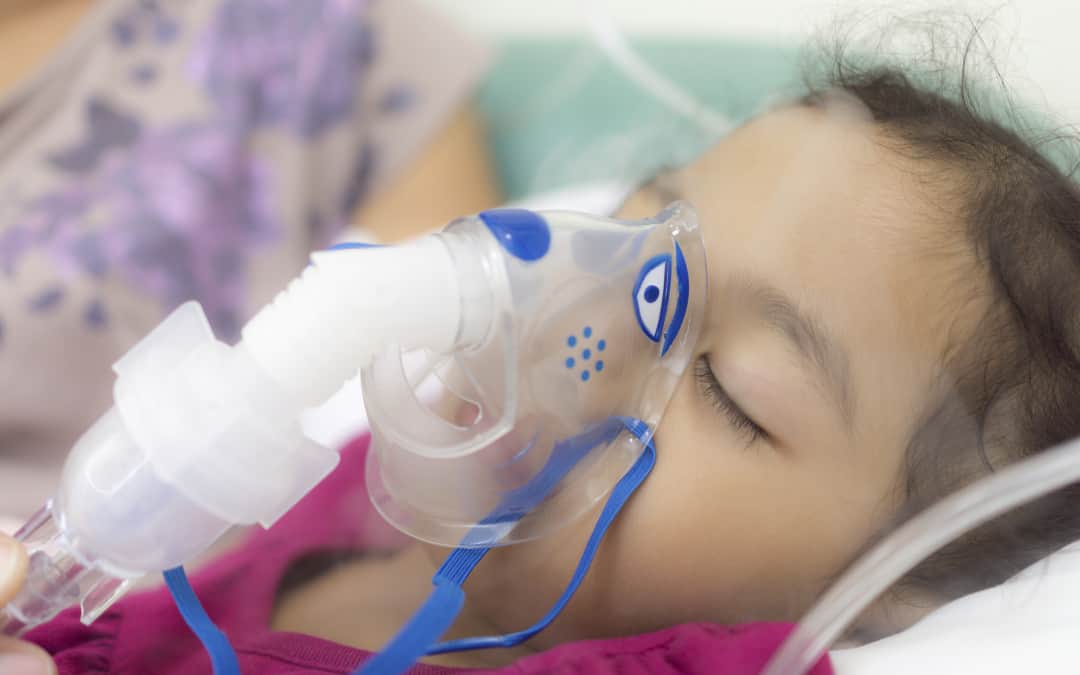Listen to the Podcast
Initial Management
Management of Acute Asthma in Infants Aged < 2 years in hospital. British Guideline on the Management of Asthma. Scottish Intercollegiate Guidelines Network, 2014. Reproduced with kind permission of SIGN.
Management of Acute Asthma in Children in Hospital. British Guideline on the Management of Asthma. Scottish Intercollegiate Guidelines Network 2014. Reproduced with kind permission of SIGN.
Airway
Intubate if there are life threatening features that are refractory to standard treatment i.e. silent chest, oxygen saturations <92%, cyanosis, poor respiratory effort, hypotension, altered consciousness or exhaustion.
In asthma the obstruction is below the level of the trachea, so intubating the asthmatic patient will not fix the problem and is likely to make things worse initially. Expect to struggle to ventilate the patient following intubation, expect and prepare for air leaks and cardiovascular compromise secondary to raised thoracic pressure impairing venous return.
A high percentage of asthmatic deaths occur during or immediately following intubation, so call for senior help early (Consultant Anaesthetist or Intensivist) and discuss with PICU prior to intubation if time allows (however don’t delay intubation for the patient in extremis).
Ensure resuscitation drugs and volume prepared prior to intubation.
Preoxygenate and administer 10 – 20 ml/kg 0.9% saline fluid bolus prior to induction.
RSI with ketamine and rocuronium by most experienced operator.
Use a cuffed tube regardless of age.
Breathing
Following intubation normal hand ventilation will rapidly lead to air trapping. Use a slow rate, allowing expiration to complete before giving the next breath.
Use a pressure mode of ventilation. High peak pressure often required, however aim to keep plateau pressure < 35 cm H2O if possible.
Keep respiratory rate low i.e. 10 – 15 breaths per minute.
Long I:E ratio e.g. 1:3 to 1:5 to allow time for expiration and prevent breath stacking. Monitor trends on ventilator flow-time display if available (not often present on transport ventilator) to ensure expiration has finished prior to initiation of next breath.
Keep PEEP low i.e. ≤ 5 cm H2O, due to patient’s own auto PEEP.
Tolerate permissive hypercapnia (CO2 up to 14 kPa), while keeping pH > 7.2 using THAM or bicarbonate (bicarbonate will increase CO2 so THAM may be better first-line).
Titrate oxygen to keep SpO2 88 – 92%, aiming to reduce FiO2 to < 0.6 when possible to reduce risk of oxygen toxicity on lungs.
Chest radiograph following intubation for endotracheal tube position. Repeat chest radiograph if any deterioration to exclude an air leak (bedside ultrasound allows rapid confirmation if skills and equipment allow).
Equipment to perform bilateral thoracocentesis and chest drain insertion should be immediately available in the bed-space and any pneumothorax must be drained prior to transfer.
Continuous monitoring of pulse oximetry and capnography is mandatory. Check blood gases regularly.
Circulation
Minimum of two peripheral cannulae and an arterial line (to allow rapid detection of hypotension from air trapping or pneumothorax). Central venous access if needing vasoactive drugs, strong KCL infusion or if difficult peripheral access (femoral site preferred).
Expect sinus tachycardic secondary to the effects of salbutamol, however hypokalaemia and effects of intravenous bronchodilators also increase the risk of arrhythmias, so continuous monitoring of ECG is mandatory.
Cardiovascular instability is likely to be due to reduced preload secondary raised intra- thoracic pressure from either breath stacking or pneumothorax. Administer 10 – 20 ml/ kg of volume as required and adjust ventilation to prevent breath stacking. In the periarrest patient disconnect from ventilator (a hiss of air will be heard if breath stacking is the problem) and consider manually compressing the chest to help remove any trapped air. If this doesn’t rectify the problem a tension pneumothorax should be suspected.
Both magnesium and volatile anaesthetic agents will cause vasodilation and contribute to any cardiovascular instability.
If required (after fluid resuscitation) support blood pressure with adrenaline or noradrenaline depending on individual haemodynamics. Both can be administered as a dilute solution peripherally or intraosseously as a temporary measure while central access is obtained. Adrenaline will have the added advantage of contributing to bronchodilation, but at the expense of increasing any salbutamol induced tachycardia, increasing the risk of arrhythmia and lactic acidosis.
Disability
Ketamine is the ideal drug for sedation in the ventilated asthmatic patient due to it’s bronchodilatory properties. Start at 1 mg/kg/hr and titrate to effect (normal range 0.6 – 2.7 mg/kg/hr).
If required Midazolam can be added at a dose of 1 – 4 mcg/kg/min.
Keep paralysed for transfer with a Rocuronium infusion (normal range 0.3 – 1 mg/kg/ hr). In PICU paralysis should be used for the minimum time necessary due to the high risk of critical illness polyneuropathy and myopathy in these patients.
Avoid use of Morphine and Atracurim due to potential for histamine release and worsening bronchospasm.
Sepsis
Don’t administer antibiotics routinely, unless the is evidence of secondary infection.
Renal
Restrict intravenous fluids to 80% maintenance.
Use isotonic fluids (risk of SIADH) with added potassium e.g. 0.9% saline and 5% dextrose with 20 mmol KCL per 500 ml.
Catheterise bladder (patient likely to be kept muscle relaxed initially) and monitor urine output.
Gastrointestinal
Keep nil by mouth.
Insert and aspirate nasogastric tube (to remove any swallowed air splinting the diaphragm), then leave on free drainage.
Labs & Electrolytes
Routinely check FBP, U&E, Ca, Mg, CRP, blood gas and lactate.
Blood cultures if starting antibiotics for secondary infection.
Theophylline level if on oral theophylline or 4 – 6 hours after starting aminophylline.
Potassium levels must be monitored frequently via the blood gas and preventative measures instituted for all patients on intravenous salbutamol even if potassium level is normal. Maximise the potassium content of intravenous fluids (maximum safe peripheral concentration in 20 mmol per 500ml) and consider additional enteral potassium via nasogastric tube once the airway has been secured. Both aminophylline and magnesium are compatible with potassium containing intravenous fluids at the y- site connector, however the compatibility of salbutamol is unknown so a separate intravenous lines/lumens must be used. For potassium levels < 3 mmol/L or if falling despite maximal peripheral and enteral potassium start a concentrated potassium infusion via a central line at 0.2 – 0.4 mmol/kg/hr with ECG monitoring and hourly levels.
Hyperglycaemia is common secondary to a combination of the stress response, steroids and salbutamol. Intravenous Insulin sliding scale may be required if this persists following transfer to PICU, however is not normally initiated outside the intensive care environment.
Drugs & Infusions
Salbutamol
Administer a loading dose of 5 micrograms/kg if age < 2 years or 15 micrograms/kg if age ≥ 2 years (maximum dose = 250 micrograms) by slow intravenous injection over 5 minutes. This should be followed by an intravenous infusion starting at 1 mcg/kg/ minute (range 0.5 – 5 micrograms/kg/minute).
The dose of intravenous salbutamol should not normally be increased above 2 mcg/kg/ min due to significantly increased side effects (tachycardia, lactic acidosis and hypokalaemia), often with no or minimal therapeutic benefit (side effects outweigh any benefit).
The normal adult dosing range for intravenous salbutamol is 3 – 20 mcg/min, therefore in children >20kg it should be noted that the normal paediatric starting dose of 1mcg/ kg/min will exceed the maximum adult dose. Consideration should be given to reducing the dose to avoid salbutamol toxicity to a maximum dose of 20 mcg/min.
Aminophylline
Administer a loading dose of 5 mg/kg (maximum dose = 500 mg) by intravenous infusion over 20 minutes. Omit loading dose if patient is already on an oral theophylline. This should be followed by an intravenous infusion of 1 mg/kg/hour if age < 12 years or 0.5 mg/kg/hour if age ≥ 12 years.
Check theophylline level 4 – 6 hours after starting the infusion and titrate to maintain plasma theophylline level between 10 – 20 mg/L.
Magnesium Sulfate
Administer 40 mg/kg by slow intravenous infusion over 20 minutes (maximum dose = 2 g).
Hydrocortisone
Administer 4 mg/kg of hydrocortisone (maximum dose = 100 mg) every 6 hours, converting to oral prednisolone when more stable and able to tolerate enterally.
Give hydrocortisone to all patients requiring intensive care, even if enteral steroids have been given, due to unreliable gastric emptying in critically ill patients.
Additional Information
For asthma refractory to the above measures consider the treatments below (although evidence for these therapies is lacking):
Volatile Anaesthetic Agents
Effect normally evident within 30 minutes of starting treatment.
As well as causing bronchodilation this will cause vasodilation so be prepared to support cardiovascular system with vasoactive drugs and consider reducing other sedatives.
Magnesium Sulfate Infusion
Following the 40 mg/kg loading dose start a continuous infusion at 30 mg/kg/hr.
Monitor magnesium levels and adjusting to maintain serum magnesium level between 1.5 – 2.5 mmol/L.
As well as causing bronchodilation this will cause vasodilation so be prepared to support cardiovascular system with vasoactive drugs.
DNase
Works as a mucolytic agent and can be instilled directed via the endotracheal tube.
Use 1.25 mg for children <10 kg and 2.5 mg for children > 10 kg.
Caution this may cause bronchospasm.
Heliox
Low density gas which improves flow by switching from turbulent to laminar flow.
Availability in district general hospital and patients oxygen requirement (contains 21% oxygen and 79% helium) normally limit usefulness.
Bronchoscopy
Expertise outside of tertiary hospital unlikely to be available. May be used for refractory cases in PICU.
Extracorporeal Life Support (ECLS)
Discuss refractory cases with ECLS centre early (normally done by transport team).
![]()




Recent Comments